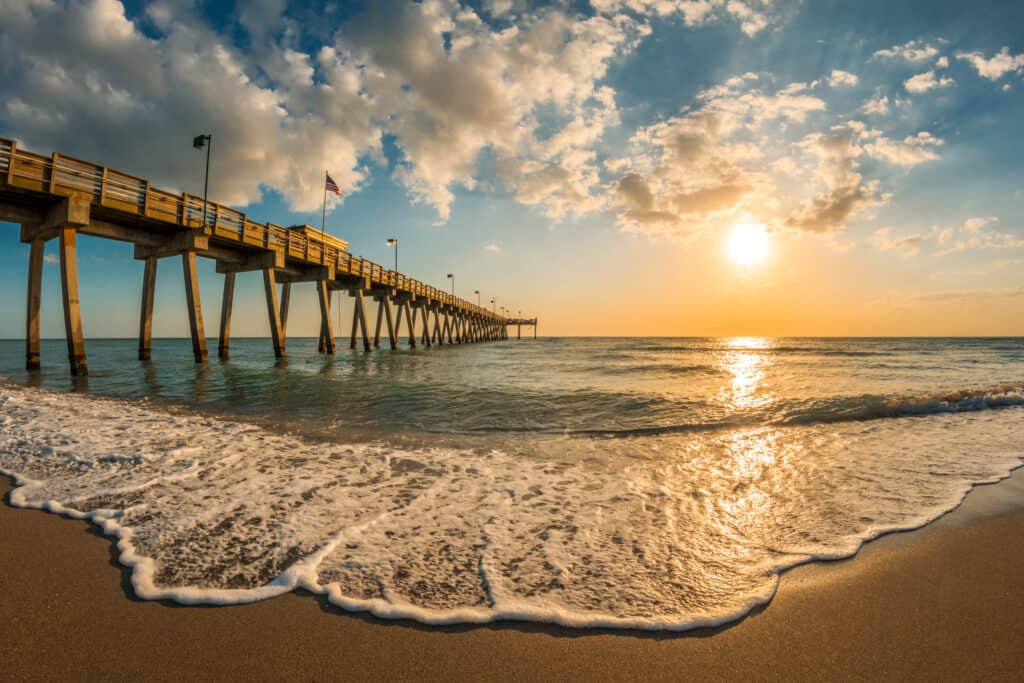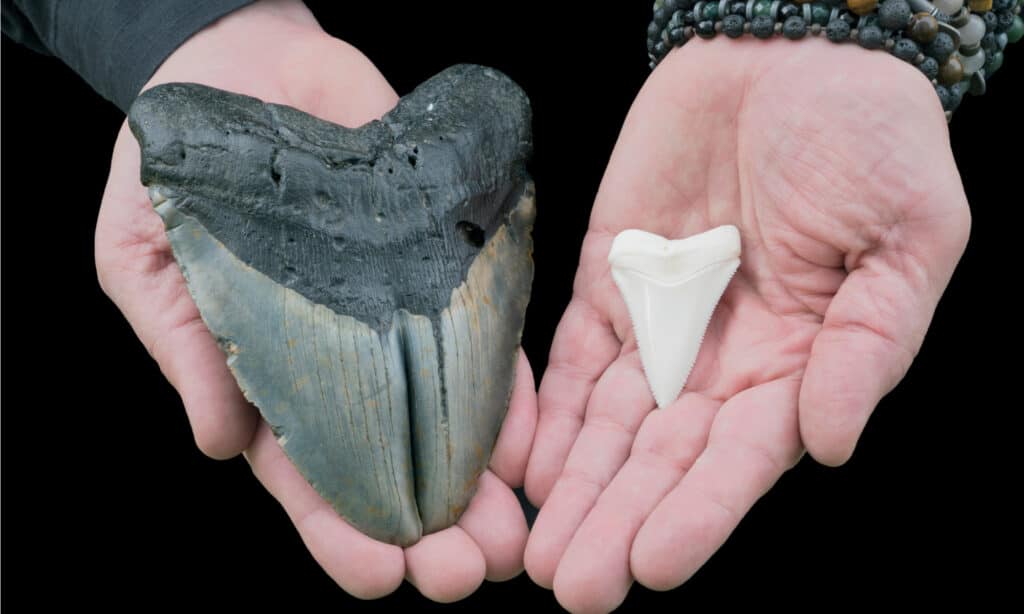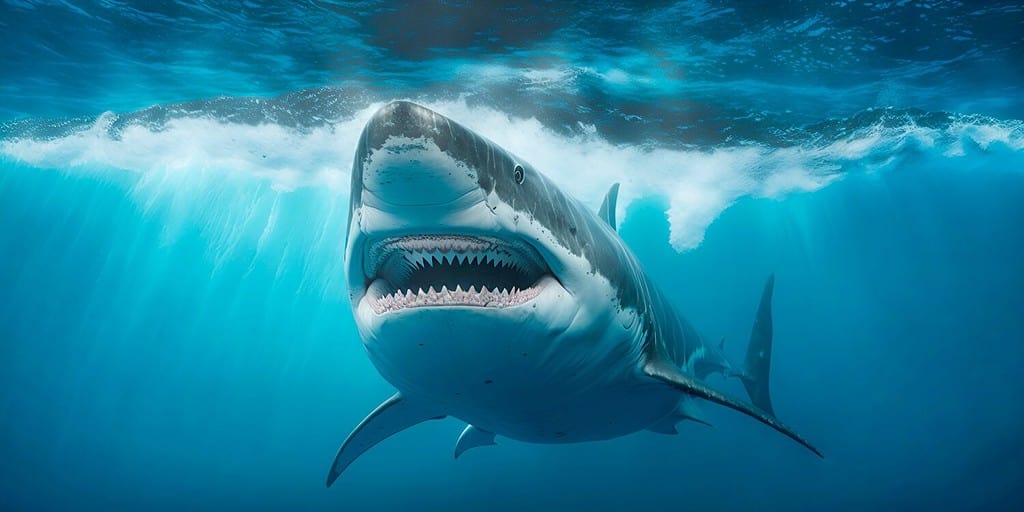
Florida is the southeasternmost state in the United States. This peninsular state is known for many things, including its alligator population and its delicious Cuban food. From the northern panhandle all the way down to the Florida Keys, the wonders of Florida do not cease to amaze. Cold springs, palm trees, national forests, surfing, amusement parks, the Kennedy Space Center, and so much more await the adventurous. In Venice, Florida, one beach is the “Shark Tooth Capital of the World”. Let’s take a closer look at that beach and learn about the area! Maybe learning about this incredible place will inspire you to plan a visit.
Why is Venice the Shark Tooth Capital of the World?

This is a view of the
Gulf of Mexico
from the Venice Beach Pier in Venice, Florida – a prime spot for shark tooth hunting!
©Jim Schwabel/Shutterstock.com
Millions of years ago, the world didn’t look like it does today. Florida as we know it now doesn’t exist, and the area was covered in water. Florida didn’t begin to emerge from the sea until 23 million years ago, and Florida, as we know it (mostly), has only been consistently above water for about 2.5 million years. For as long as sharks have existed, they have lived around Florida. In fact, since Florida was submerged during the time of the dinosaurs, sharks just hung out in the waters above Florida. You won’t find any dinosaur fossils in Florida but you will find shark fossils (mostly teeth)!
The sharks that swam in the waters ten million years ago are not the same as the sharks that inhabit the waters today. Many prehistoric sharks do not resemble their living descendants very much at all, but their teeth live on to tell their story. In the Venice coastal area, a fossil layer running up to 35 feet deep stores the teeth of a wide variety of sharks across history – and prehistory. This creates a prime location for shark tooth fossil hunting.
The Best Time to Hunt for Shark Teeth
As we said before, the fossil layer is up to 35 feet deep. The fossilized teeth most commonly end up exposed after storms and large waves, but you can really find them any time. A large storm may yield a larger haul of shark fossils. The teeth are shiny, so hunting in the sunlight helps. Make sure to wear sunscreen on sunny days and bring hydration if you are beachcombing. Also, bring a small bag or container for your finds! You might find treasures other than shark teeth, such as shells, pieces of sea glass, or other oddities.
How to Find Shark Teeth

Shark teeth come in all shapes and sizes! On the left is a fossilized
megalodon
tooth and on the right is the tooth of a Great White Shark.
©Mark_Kostich/Shutterstock.com
There are a few different methods for finding shark teeth. You can simply walk down any of the beaches south of Venice to find the fossilized teeth of Lemon, Bull, Mako, Mastodon, or Whitetip sharks. This is the most common – and likely most simple – method of shark tooth hunting. It might take a while, but you’re sure to stumble across one if you look for long enough.
You can also bring a shovel or scoop and look for the teeth at the water’s edge. Many people have luck straining scoops of sand near the waves to look for teeth. This may prove to be a faster and more effective method. If you are short on time or have many activities planned, you may want to try this.
More adventurous collectors might try off-shore expeditions for teeth. You can dive for teeth or go on boating expeditions to find them. While both of these methods are more expensive, intensive, and time-consuming, they also have some perks. For example, you’re more likely to find larger teeth further offshore. Also, diving has the added benefit of underwater observation and exploration. Be careful, though, Florida is still a shark hotspot. Sharks are not the vicious beasts movies like “Jaws” make them out to be, but we do have to be conscious that we are sharing their waters with them.
What Can I Do With a Shark Tooth?
There are plenty of cool things you can do with a shark tooth once you find it. Some people just like to keep them on a shelf for a keepsake. Some keep them in a jar of teeth, preserve them in rosin, turn them into jewelry, or include them in their art. You can paint them, sell them, put them in a shadow box, gift them to friends and family, or offer them to local museums. Some shark teeth are incredibly rare and worth a large amount of money – up to $1,000 – but most are just really cool treasures that you can share.
Significance of Shark Teeth
Shark teeth have had cultural and spiritual significance for a long time. Several Native American tribes held them as symbols of courage and protection. Many tribes believed they helped to ward off negative energies. In fact, many cultures included protection in their beliefs about shark teeth.
Hawaiians have ancient mythology that speaks of a warrior who battles an ocean God and wins, emerging from the sea wearing a shark tooth. Surfers now often wear shark tooth jewelry as a good luck charm as a protection talisman. The people of Fiji also have mythology about sharks and Gods. A shark-God, to be more precise. Dakuwaqa, half-man, half-shark was a shark God of the ancient people of Fiji. They believed that shark teeth carried the spirit of Dakuwaqa, so they wore them for good luck. The Maori people of New Zealand passed shark tooth necklaces from generation to generation as symbols of strength, energy, and power. They believe wearing the shark tooth amulet imbues the wearer with the spirit of the shark.
So much symbolism across so many different tribes and cultures. We should not take that symbolism lightly. Though you may not connect with the beliefs listed above, shark teeth are still very cool – and quite precious in their own way. We should honor and respect the history they offer us.
Where is Venice, Florida on a Map?
Venice, Florida is on the western side of the peninsula, south of Tampa, Florida. Highway 41 is the nearest highway, and this highway takes you directly through the city. The highway can be accessed from the 75 via the 681 just south of Oscar Scherer State Park. Venice is only 73 miles from Tampa and 60 miles from Fort Myers.
You can see a couple of beaches on this map, but there are tons of places to go look for shark teeth while getting an incredible view. Most websites recommend looking for the teeth anywhere south of the Venice Jetty. A few good places to look might be Caspersen Beach, The Venice Fishing Pier at Brohard Park, Manasota Key Beach, and Blind Pass Beach.
Fun Facts About Shark Teeth

Sharks have between 50 and 300 teeth at any given time! Look at all of the teeth in this mouth – and you can’t even see them all.
©LuckyStep/Shutterstock.com
So what’s so cool about shark teeth anyway? Well, it’s pretty cool that we can walk down a beach and find a shark tooth that could be from thousands – or even millions – of years ago. But that’s not the only thing that’s cool about shark teeth – or sharks. Here’s a short list of fun facts to conclude this article!
- Sharks produce and lose anywhere from 20,000-35,000 teeth in their lifetimes.
- Baby sharks – called pups – are born fully equipped with a set of teeth.
- Shark teeth are arranged in rows and can be replaced in as little as a day – like a conveyor belt.
- Most sharks only have 5-15 rows of teeth at a time, but bull sharks have up to 50 rows of teeth!
- Shark teeth and human teeth are about the same density!
- Shark teeth don’t have roots, which is why they lose them so easily.
- Sharks lose at least one tooth a week.
The photo featured at the top of this post is © Ryan M. Bolton/Shutterstock.com
Thank you for reading! Have some feedback for us? Contact the AZ Animals editorial team.







